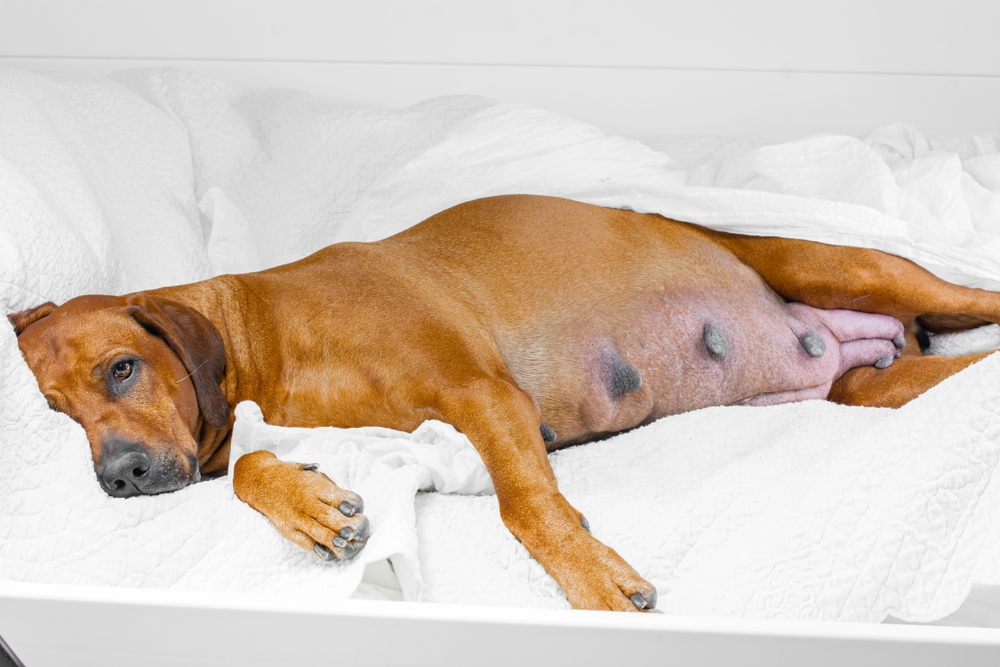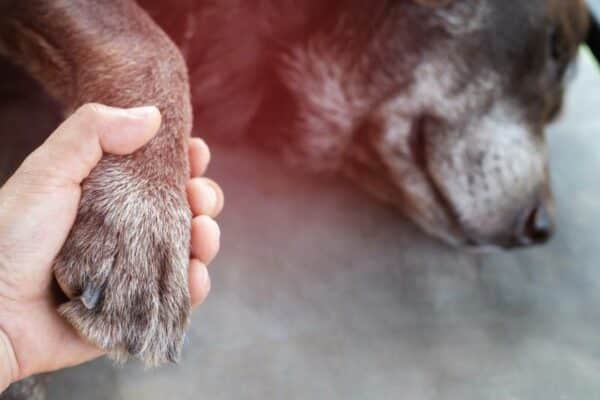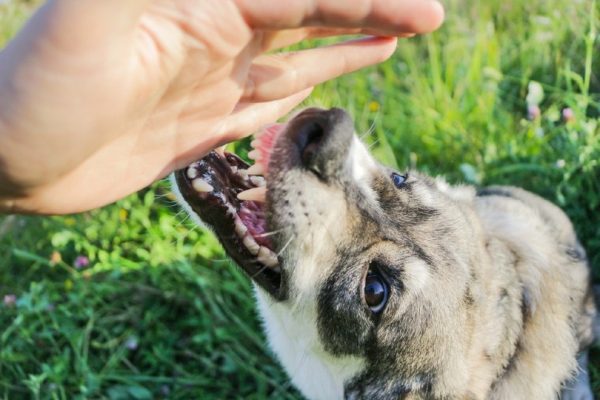Dystocia is the scientific term for a difficult birth. In other words, your female dog is unable to naturally pass their puppies through their birth canal. Dystocia can lead to maternal distress, fetal distress, and almost always leads to birth by C-section. Some breeds have a much higher risk of dystocia than others, though we can see this occur in any size, breed, or age of dog. If you plan on breeding your female dog, you need to be prepared for all that comes with that – including the risk of dystocia.

What Is Dystocia?
Dystocia is the inability of a female dog (known as a bitch) to give birth naturally. In other words, for numerous reasons, they may be unable to pass their puppies from their uterus through the birth canal. Sometimes dystocia can be treated with medications to help with contractions. However, more commonly, a female dog suffering from dystocia will need to have surgery (C-section) to remove the puppies.

What Are the Signs of Dystocia In a Dog?
If your bitch has been purposely bred, it’s important that you know the exact date this occurred. If your dog had an accidental breeding, it’s also important to mark down the exact date, or range of dates. This is because you should know when your dog is due to give birth. On average, a healthy pregnancy in a dog should last an average of 64 days. If your dog has gone past 70 days of pregnancy, they are considered over term. If your dog is showing no signs of labor by day 70, you should seek veterinary assistance.
Once your dog has started to show signs of active labor – nesting, panting, active abdominal contractions – they should start to pass the puppies within 1 hour. If they are continuously pushing/having abdominal contractions without passing any puppies within an hour, your dog is exhibiting signs of dystocia and they should be seen by a veterinarian.
If your dog has passed one puppy without complications within the first hour, monitor them closely for the continuation of labor. The rest of the puppies should be delivered naturally within 4–6 hours, averaging about an hour between puppies, pending your dog and/or the puppies are not distressed. If your dog is having abdominal contractions without producing any puppies, is panting, uncomfortable, passing copious amounts of green, black, and/or bloody discharge, they may be experiencing dystocia and seen by a veterinarian.
Another common sign of dystocia is a visible puppy stuck within the birth canal. Some dogs will be unable to pass the entire fetus through the birth canal because the puppy’s body and/or head is too large to fit naturally. We also see this commonly with dogs such as the Bulldog, when their pelvic canal is too narrow for a normal sized fetus to pass. You may notice a leg, foot, or portion of the puppy’s body hanging out of your dog’s birth canal but they are unable to push it the rest of the way.

What Are the Causes of Dystocia?
The most common reason we see dystocia in veterinary medicine is due to human interference with poor breeding. That’s right, human beings are the reason why many dogs are unable to give birth naturally. Over the years, we have continuously bred dogs for their physical appearance and taken away their bodies’ ability to function normally. Breeds such as the English Bulldog, French Bulldog, Miniature Poodles, Yorkies, and other small breed dogs often experience complications with a natural birth. Compound that with irresponsible breeding and we have created a perfect storm for these poor pups. This is often because these dogs’ pelvic canals are too narrow to be able to naturally pass one or multiple puppies.
Other times, puppies may develop and be too large, have abnormal anatomy, or other congenital abnormalities making it impossible for the mom to pass them naturally. Puppies which present sideways in the birth canal (transverse position) are also unable to pass, though this is very uncommon. A bitch can pass a puppy that is head first (anterior) or feet first (breech), as long as the spine of the puppy is on the top. If the puppy is spine down, this may cause dystocia.
In other cases, your dog may have one or multiple dead puppies. These may lead to inappropriate signals telling the uterus to contract and initiate labor. Therefore your dog may not be able to give birth because their body has not been triggered to do this. In other cases, abnormal nutrition, concurrent disease, and multiple other factors may lead to an inability of the uterus to contract normally during the birthing process.
How Do I Care for a Dog in Dystocia
If your dog is showing any signs of dystocia, or is a high-risk breed, then you should seek veterinary care or at minimum call your veterinarian if you are concerned. Depending on what’s going on, your veterinarian may or may not recommend you come in immediately to the hospital as stress can sometimes delay labor.
If you need to speak with a vet but can't get to one, head over to PangoVet. It's our online service where you can talk to a vet online and get the advice you need for your pet — all at an affordable price!
Your veterinarian will do a full exam and likely take radiographs to visualize the size and position of the first puppy. If your veterinarian is able to reposition the puppy, they may try to see if your dog can then pass the puppy naturally. Medications are also sometimes given to the bitch to strengthen the contractions and also increase the frequency of contractions. If neither of these work, then an emergency C-section may be recommended.
High risk breeds, or smaller dogs whose pelvic canal is too narrow to pass any puppies, may be taken straight to surgery. Many veterinarians will only do emergency surgery if a spay is completed at the same time. This is because this type of surgery is much quicker, allowing the puppies to be removed and revived much quicker. It will also help prevent any future pregnancy complications with the bitch if she no longer has a uterus.
Medications should never be given at home to try to induce labor or help with contractions. Old wives’ tales talk about giving mineral oil and other concoctions to help both people and animals have successful births. The truth of the matter is that if your dog’s pelvis is too narrow, the puppies are too large, etc., then no amount of medication is going to get the puppies to pass.

Frequently Asked Questions (FAQ)
Is Emergency Surgery Expensive?
Yes. An emergency c-section and/or spay is very expensive, sometimes into the thousands of dollars. This is because of the urgent nature of the procedure and also the delicacy with which both the mom and babies need to be handled. This is one of the many reasons why veterinarians would rather just spay your healthy dog when they are young and not pregnant versus dealing with a dystocia years down the line.
Can My Dog Die from Dystocia?
Yes. This is a medical emergency if a true dystocia. If the puppies are already dead and/or pass away, then the bitch is at risk for sepsis. If the bitch has been struggling and unable to pass the puppies, and/or surgery cannot be pursued, then she may very likely pass from complications.
How Can I Prevent Dystocia?
Sometimes dystocia cannot be predicted and/or prevented. If you own a high-risk breed, it’s typically not recommended to breed them because of their risk of complications. If you still choose to breed your dog, or it was accidental, then work with your veterinarian prior to the birthing date for instructions on appropriate diet, preparation, and diagnostics. We also strongly recommend pet insurance or an emergency fund for emergency surgery.

Conclusion
Dystocia in a dog is when a pregnant female dog, or bitch, is unable to naturally pass their puppies. This can occur simply from a dog’s breed and their inability to pass any puppies due to a narrow birth canal. Other times the puppies may be too large to pass through the birth canal or be in an abnormal position. Still other times the uterus is unable to signal and/or proceed through normal birth. If your dog has gone more than 70 days since their breeding, you should seek veterinary care. If your dog has had active abdominal contractions for more than 1 hour, and/or more than 1 hour has passed between puppies, or your dog seems at all distressed, you should seek veterinary care. Medications can sometimes be given to help with dystocia but more commonly surgery needs to be pursued. Keep in mind that if you choose to own a high risk-breed and purposely breed it, you should be well aware of the risks and financial undertaking you are responsible for.
Featured Image Credit: Vera Shcher, Shutterstock



















